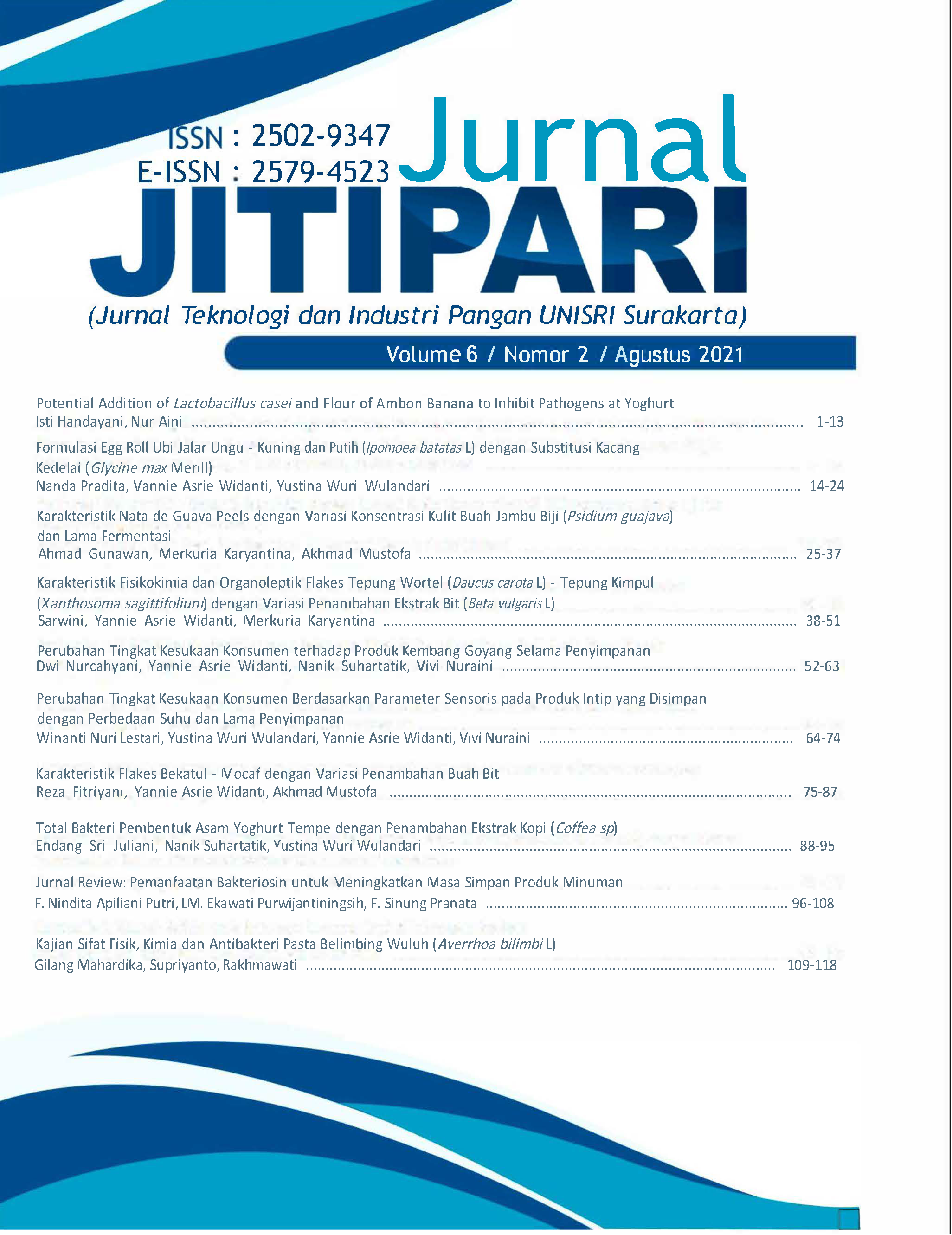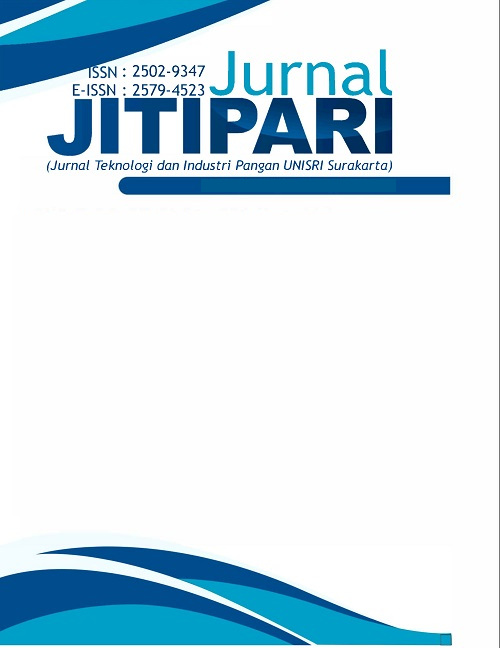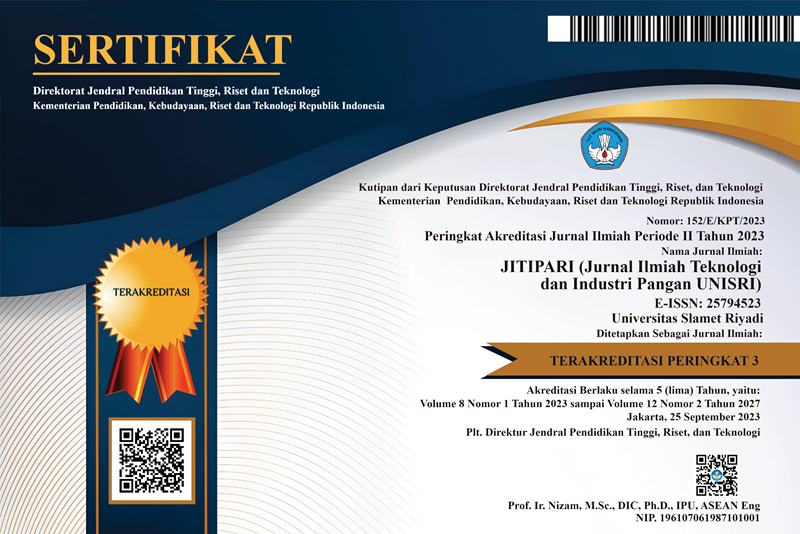POTENTIAL ADDITION OF Lactobacillus casei AND FLOUR OF AMBON BANANA TO INHIBIT PATHOGENS AT YOGURT
DOI:
https://doi.org/10.33061/jitipari.v6i2.5008Keywords:
Ambon banana flour, E. coli, inhibition, L.casei, S. aureusAbstract
This study aims to determine the effect of Lactobacillus casei and Ambon banana flour on the viability of lactic acid bacteria and inhibition of pathogens in yogurt. The studies used the Randomized Block Design (RBD) 2 factor, starter type and ambon banana flour concentration. The starters type consisting of Streptococcus thermophillus and Lactobacillus bulgaricus; S. thermophilus, L. bulgaricus and L. casei. The banana flour concentration consisting of 0; 2.5; 5.0; 7.5 and 10%. Analyzed used one-way ANOVA and continued with Duncan's Multiple Range Test. Variables observed including the viability of lactic acid bacteria, inhibition of pathogen (Escherichia coli and Staphylococcus aureus), and yogurt preference. The results showed that the addition of L. casei to yogurt cultures decreased the viability of lactic acid bacteria and inhibition of E. coli but increased inhibition of S. aureus. Increasing the concentration of banana flour causes increased viability of lactic acid bacteria, inhibiting against E. coli and S. aureus. The highest lactic acid bacteria viability has resulted in 10% banana flour concentration. Yogurt without the addition of banana flour cannot inhibit E. coli and S. aureus. Increasing the concentration of banana flour added to yogurt causes a decrease in preference.
References
Abed, S. M., Ali, A. H., Noman, A., & Bakry, A. M. (2016). Inulin as Prebiotics and its Applications in Food Industry and Human Health; A review. International Journal of Agriculture Innovations and Research, 5(1), 2319–1473. https://pdfs.semanticscholar.org/0a86/aa31a7a06f89a9c930b2adce8f9744258bc6.pdf
Annuk, H., Shchepetova, J., Kullisaar, T., Songisepp, E., Zilmer, M., & Mikelsaar, M. (2003). Characterization of intestinal lactobacilli as putative probiotic candidates. Journal of Applied Microbiology, 94(3), 403–412. https://doi.org/10.1046/j.1365-2672.2003.01847.x
Aslam, M., Shahid, M., Rehman, F. U., Naveed, N. H., Batool, A. I., Sharif, S., & Asia, A. (2011). Purification and characterization of bacteriocin isolated from Streptococcus thermophillus. African Journal of Microbiology Research, 5(18), 2642–2648. https://doi.org/10.5897/AJMR11.225
Davani-Davari, D., Negahdaripour, M., Karimzadeh, I., Seifan, M., Mohkam, M., Masoumi, S. J., Berenjian, A., & Ghasemi, Y. (2019). Prebiotics: Definition, types, sources, mechanisms, and clinical applications. Foods, 8(3), 1–27. https://doi.org/10.3390/foods8030092
Davis, W. W., & Stout, T. R. (1971). Disc plate method of microbiological antibiotic assay. I. Factors influencing variability and error. Applied Microbiology, 22(4), 659–665. https://doi.org/10.1128/aem.22.4.659-665.1971
De Vuyst, L., & Leroy, F. (2007). Bacteriocins from lactic acid bacteria: Production, purification, and food applications. Journal of Molecular Microbiology and Biotechnology, 13(4), 194–199. https://doi.org/10.1159/000104752
Endo, A., Futagawa-Endo, Y., & Dicks, L. M. T. (2011). Influence of carbohydrates on the isolation of lactic acid bacteria. Journal of Applied Microbiology, 110(4), 1085–1092. https://doi.org/10.1111/j.1365-2672.2011.04966.x
Hapsari, L., & Lestari, D. A. (2016). Fruit characteristic and nutrient values of four Indonesian banana cultivars (Musa spp.) at different genomic groups. Agrivita, 38(3), 303–311. https://doi.org/10.17503/agrivita.v38i3.696
Hardisari, R., & Amaliawati, N. (2016). Manfaat Prebiotik Tepung Pisang Kepok (Musa paradisiaca formatypica) terhadap Pertumbuhan Probiotik Lactobacillus casei secara In Vitro. Jurnal Teknologi Laboratorium, 5(2), 64–67.
Jimenez-Diaz, R., Rios-Sanchez, R. M., Desmazeaud, M., Ruiz-Barba, J. L., & Piard -, J. C. (1993). Plantaricins S and T, two new bacteriocins produced by Lactobacillus plantarum LPCO10 isolated from a green olive fermentation. Applied and Environmental Microbiology, 59(5), 1416–1424. https://doi.org/10.1128/aem.59.5.1416-1424.1993
Kumalasari, K. E. D., Legowo, A. M., & Al-Baarri, A. N. (2013). Total Bakteri Asam Laktat , Kadar Laktosa , pH , Keasaman , Kesukaan Drink Yogurt dengan Penambahan Ekstrak Buah Kelengkeng. Jurnal Aplikasi Teknologi Pangan, 2(4), 165–168.
Mohammaddoost Chakoosari, M., Faezi Ghasemi, M., Masiha, A., Kazemi Darsanaki, R., & Amini, A. (2015). Antimicrobial Effect of Lactic Acid Bacteria against Common Pathogenic Bacteria. Medical Laboratory Journal, 9(5), 4–1. https://doi.org/10.18869/acadpub.mlj.9.5.4
Mora-Villalobos, J. A., Montero-Zamora, J., Barboza, N., Rojas-Garbanzo, C., Usaga, J., Redondo-Solano, M., Schroedter, L., Olszewska-Widdrat, A., & Lopez-Gomez, J. P. (2020). Multi-Product Lactic Acid Bacteria Fermentations : Fermentation, 1–21.
Moshfegh, A. J., Friday, J. E., Goldman, J. P., & Chug Ahuja, J. K. (1999). Presence of inulin and oligofructose in the diets of Americans. Journal of Nutrition, 129(7 SUPPL.), 1407–1411. https://doi.org/10.1093/jn/129.7.1407s
Niken Tari, A. I., Handayani, C. B., & Sudarmi, S. (2016). Potensi Probiotik Indigenus Lactobacillus plantarum Dad 13 pada Yogurt dengan Suplementasi Ekstrak Ubi Jalar Ungu untuk Penurun Diare dan Radikal Bebas. Jurnal Agritech, 36(01), 7. https://doi.org/10.22146/agritech.10677
Nurwantoro, N., Susanti, S., & Rizqiati, H. (2020). The Effect of Different Type Drying Methods on Chemical Characteristics and Microbiology of Goat Milk Powder Kefir. Journal of Applied Food Technology, 7(1), 19–24. https://doi.org/10.17728/jaft.6699
Pandey, K. R., Naik, S. R., & Vakil, B. V. (2015). Probiotics, prebiotics and synbiotics- a review. Journal of Food Science and Technology, 52(12), 7577–7587. https://doi.org/10.1007/s13197-015-1921-1
Petry, S., Furlan, S., Crepeau, M. J., Cerning, J., & Desmazeaud, M. (2000). Factors affecting exocellular polysaccharide production by Lactobacillus delbrueckii subsp. bulgaricus grown in a chemically defined medium. Applied and Environmental Microbiology, 66(8), 3427–3431. https://doi.org/10.1128/AEM.66.8.3427-3431.2000
Pınar, Ş., & Yalçın, G. (2015). Antomicrobial activity of lactic acid bacteria. Agriculture & Food, 3(9), 451–457.
Radlović, N., Leković, Z., Vuletić, B., Radlović, V., & Simić, D. (2015). Acute diarrhea in children. Srpski Arhiv Za Celokupno Lekarstvo, 143(11–12), 755–762. https://doi.org/10.2298/SARH1512755R
Rahayu, E. S., Yogeswara, A., & Utami, T. (2011). Pa-198. 400–404.
Rahmawati, R., & Basriman, I. (2017). Pengaruh Jenis Starter Terhadap Mutu Zeagurt Probiotik. Jurnal Konversi, 6(1), 19. https://doi.org/10.24853/konversi.6.1.19-30
Setiarto, R. H. B., Widhyastuti, N., Fairuz, I., Pangan, L. M., Mikrobiologi, B., Barat, J., Pertanian, J. K., Pertanian, F. T., & Malang, U. B. (2017). Pengaruh starter bakteri asam laktat dan penambahan tepung talas termodifikasi terhadap kualitas yogurt sinbiotik effect of lactic acid bacteria starter and the fortification of modified taro flour on the quality of synbiotic yogurt. 18–30.
Sudarmadji, S., Haryono, B., S. (1997). Prosedur Analisis Untuk Bahan Makanan dan pertanian. Liberty, Yogyakarta.
Tari, I. N., & Handayani, C. B. (2015). Uji Potensi Antidiare Lactobacillus sp Indigenous Sebagai Kultur Starter pada Yogurt dengan Suplementasi Ekstrak Ubi Jalar Ungu. Jurnal Teknologi Hasil Pertanian, 8(2), 63. https://doi.org/10.20961/jthp.v0i0.12890
Thammarutwasik, P., Hongpattarakere, T., Chantachum, S., Kijroongrojana, K., Itharat, A., Reanmongkol, W., Tewtrakul, S., & Ooraikul, B. (2009). Prebiotics – A Review. 31(4), 401–408.
Yuliana, N. (2008). Kinwtika Pertumbuhan Bakteri Asam Laktat Isolat T5 Yang Berasal Dari Tempoyak. Jurnal Teknologi Industri Dan Hasil Pertanian, 13(2), 108–116.
Downloads
Published
How to Cite
Issue
Section
License
Copyright (c) 2021 Isti Handayani

This work is licensed under a Creative Commons Attribution-NonCommercial 4.0 International License.
Authors who publish this journal agree to the following terms:
- Authors retain copyright and grant the journal right of first publication with the work simultaneously licensed under a Creative Commons Attribution-ShareAlike 4.0 International (CC BY-SA 4.0) that allows others to share the work with an acknowledgement of the work's authorship and initial publication in this journal.
- Authors can separately make additional contractual arrangements for non-exclusive distribution published by the journal (e.g., publish it in a book), with an acknowledgement of its initial publication in this journal.
- Authors are allowed and encouraged to send their work via online (e.g., in the institutional repositories or their website) after published by the journal.










